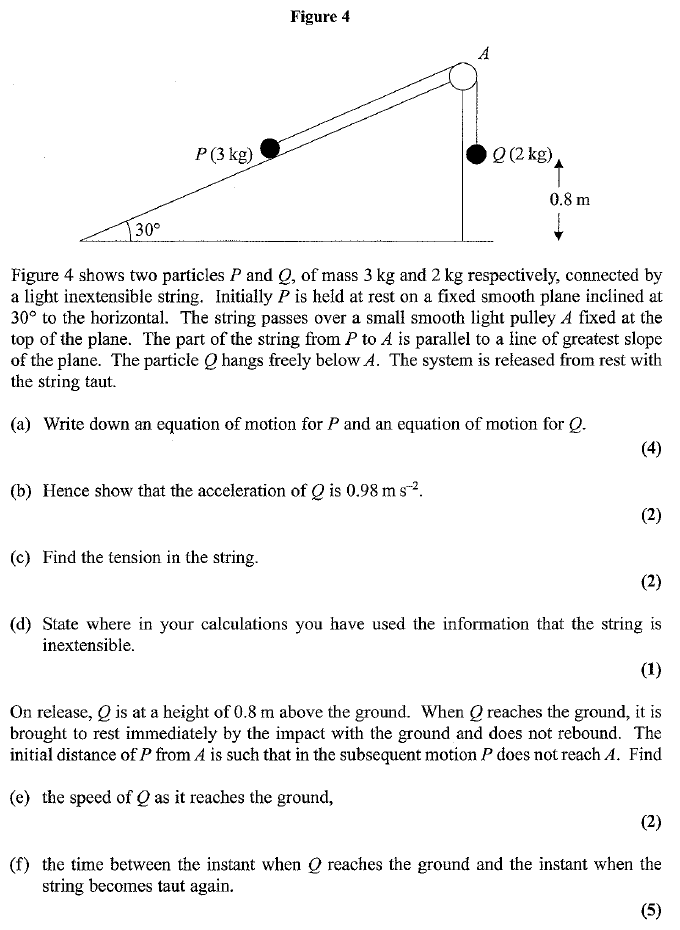Have you ever watched a rollercoaster ascend a steep incline, only to be launched into a thrilling descent? Or perhaps you’ve witnessed a heavy box effortlessly slide down a ramp, defying gravity? These scenarios exemplify the power of inclined planes, a simple yet fascinating concept in physics. Inclined planes, whether they’re ramps, hillsides, or even the slopes of a roof, play a crucial role in our daily lives. They affect how we move objects, design structures, and even understand the forces at play in our world. But how do we navigate the complexities of inclined planes? What are the fundamental principles that govern their behavior? And most importantly, how can we conquer the challenges of inclined plane problems?

Image: www.examsolutions.net
This article dives deep into the world of inclined planes, equipping you with the knowledge and skills to tackle any problem that comes your way. We’ll unravel the mysteries of forces, friction, and acceleration on inclined surfaces, providing you with a clear understanding of the physics behind these seemingly simple yet powerful mechanisms. We’ll also explore real-world applications of inclined planes, demonstrating their relevance in various fields ranging from engineering and architecture to sports and everyday activities. By the end of this journey, you will not only understand the intricacies of inclined planes but also have a PDF resource at hand, filled with practice problems and solutions to solidify your understanding. So, let’s embark on this exciting exploration together!
Unveiling the Inclined Plane: A Fundamental Concept in Physics
An inclined plane, in its simplest form, is a flat surface tilted at an angle to the horizontal. These angles are responsible for the fascinating interplay of forces that dictate the motion of objects placed on them. The primary forces involved are gravity, which acts downwards, and the normal force, pushing perpendicular to the plane’s surface. However, the angle of inclination, often represented by the Greek letter theta (θ), throws a wrench into the equation, splitting the force of gravity into two components. One component, acting parallel to the inclined plane, drives the object’s motion. The other component, perpendicular to the plane, is balanced by the normal force.
Understanding these forces is essential for solving inclined plane problems. We’ll delve deeper into each force, exploring their interactions and how their magnitudes are calculated. We’ll use diagrams and equations to clarify the concepts, making them approachable even for those with limited physics background.
Navigating the Labyrinth of Inclined Plane Problems: A Step-by-Step Approach
Inclined plane problems often involve calculating the acceleration of an object on the ramp, its velocity, or even the work done against friction. These problems might seem daunting at first, but they become manageable with a systematic approach. Here’s a roadmap to guide you through the process:
- Identify the forces: Begin by identifying all the forces acting on the object. This includes gravity (mg), the normal force (N), and the force of friction (Ff).
- Resolve forces: Next, resolve the force of gravity into its components: the force acting parallel to the inclined plane (mg sin θ) and the force acting perpendicular to the plane (mg cos θ).
- Apply Newton’s Second Law: Apply Newton’s Second Law (F = ma) to the object along the incline. This means summing up all the forces acting parallel to the plane, setting it equal to the object’s mass times its acceleration.
- Solve for the unknowns: With the equation set up, you can solve for the unknown quantities, such as acceleration, velocity, or work done.
Cracking the Code: Common Scenarios and Solutions
Let’s explore some common scenarios involving inclined planes and how to tackle them effectively:
Scenario 1: Object Sliding Down a Frictionless Inclined Plane
In this ideal scenario, the absence of friction simplifies the problem. The only force acting parallel to the plane is mg sin θ, causing the object to accelerate downwards. By applying Newton’s Second Law, we can solve for acceleration (a = g sin θ).
Scenario 2: Object Sliding Down an Inclined Plane with Friction
The presence of friction introduces a new force opposing the motion. To solve this, we need to consider the kinetic friction force (Ff = μkN), where μk is the coefficient of kinetic friction and N is the normal force. The net force parallel to the plane becomes mg sin θ – μkN. Substituting μk(mg cos θ) for N, we can readily solve for acceleration.
Scenario 3: Object Pulled Upwards on an Inclined Plane
When an external force pulls the object upwards, we need to consider the direction of forces carefully. The net force parallel to the plane becomes F – mg sin θ – μkN, where F is the applied force. Solving for acceleration requires mindful consideration of these forces.

Image: printablefullkarissa123.s3-website-us-east-1.amazonaws.com
Practical Applications: Inclined Planes in Our World
Inclined planes are ubiquitous in our daily lives. Here are some examples showcasing their practical significance:
- Ramps: Ramps are essential for accessibility, allowing wheelchair users, those with mobility limitations, and even vehicles to navigate vertical barriers.
- Slides: Children’s slides and water slides are classic examples of inclined planes. The angle allows for controlled and exhilarating descent.
- Conveyor belts: Conveyor belts in factories and warehouses use the principles of inclined planes to move products efficiently and with minimal effort.
- Ski slopes: Skiing and snowboarding are popular activities that rely on the slopes of mountains, which act as inclined planes.
- Roofing: The slope of a roof is crucial for drainage and prevents water accumulation, which can lead to structural damage.
Unlocking Expertise: Mastering the Inclined Plane
To truly master the inclined plane, it’s essential to seek knowledge from experts in the field. Textbook examples and online tutorials can provide valuable insights, but seeking guidance from experienced physicists or engineering professionals can offer a deeper understanding and equip you with practical problem-solving skills. Moreover, join online forums or physics communities to engage in discussions, share your learning experiences, and learn from the insights of fellow learners.
Inclined Plane Problems And Answers Pdf
Conquering the Climb: A Call to Action
As we conclude this exploration of inclined planes, remember that understanding these fundamental concepts has far-reaching implications. Whether you’re an aspiring engineer, a curious student, or simply someone fascinated by the physics of everyday phenomena, mastering inclined planes can open doors to new possibilities.
To further your learning and solidify your understanding, download the accompanying PDF containing practice problems and solutions. Work through these problems, applying the knowledge gained throughout this article. Don’t be afraid to delve deeper into related concepts, such as work, energy, and power.
Remember, unlocking the mysteries of inclined planes is not just about solving complex problems. It’s about expanding your knowledge, enhancing your problem-solving skills, and appreciating the intricate interplay of forces that shape our world.






